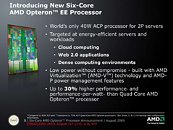Monday, August 31st 2009

AMD Announces Six-Core Opteron EE Processor with 40W ACP
AMD today announced the immediate availability of the new Six-Core AMD Opteron EE processor at 40W ACP. Delivering up to 31 percent higher performance-per-watt over standard Quad-Core AMD Opteron processors, the Six-Core AMD Opteron EE processor is tailored to meet the demands of customers who need strong performance, but must trim out every watt possible in a server system and reduce the datacenter's power draw.
- Many customers requiring this very low power processor deploy dense, large-scale IT projects where system power trumps raw performance and every watt of power savings can have significant positive impact on the bottom line
- AMD offers a wide range of energy-efficient processors; customers now have 15 low and very low power server processor choices available
- All of AMD's low power processors are fully-featured and available with the same AMD Virtualization (AMD-V) technology and AMD-P features for advanced virtualization and power savings capability as standard power versions
- This 40W ACP processor is currently being integrated in custom solutions programs and will be available from system builders for cloud and Web 2.0 customers where density and low power are key considerations

25 Comments on AMD Announces Six-Core Opteron EE Processor with 40W ACP
Now Average Joe (and some of you already) will see then wattage and not see the ACP that has no meaning for him, and think that the AMD 40W ACP processor is much more power efficient then the 65W TDP Intel processor... See?
its not bad really, its a great choice in the server environment.
All this text just to say..Advertisement is for catching up people who don't know. Sales are easier when you foul ignorant people than when you informs people who know the subject because theres more ignorants than people who knows. Also too much technics in an advert it look like a brag to the "mass" people. :ohwell:
Besides that, you are dead on.
the best way to know, is to measure the consumption and see how efficient it is
Just a little car history and fyi for everyone. lol.
As far as this cpu, 60W TDP out of a hexacore is still mighty impressive.
And a 60W TDP for full power operation still makes this a awsome chip at the speed, considering most server systems are thread bound, where more cores means more work being done, or the ability to assign cores to workloads means more than processing speed.
Numbers taken from specs sheets of various Opteron models. ACP doesn't share a math relation with TDP (since they're both rated values, not measurements). They're just products of blindfolded primates playing darts at AMD/Intel who failed to properly explain ACP/TDP to analysts.
Well that is BS! Intel L5410/L5420 = TDP 50W, which is 20% less than AMD's 60W TDP.
WHAT A LOAD OF OLD SPIN.
OK, so they are trying to split hairs. They mean only "6 core CPU at 40W ACP". Fair enough. But I bet intel's L5530 which is 4 core + 4 HTT = 8 virtual cores is faster AND is in the same TDP/ACP envelope. So it's all down to multitask performance per watt. Let's see some real numbers...
Now, that Nehalem and the current Opteron line have the same architectural design (at least if you look at a feature set checklist it seems the same, integrated memory controller, comparable L3 caches etc.) and the results are still better for Intel, AMD really has nothing else to complain about. As a result they "invented" this ACP measuring scheme that unfortunately no one else recognizes.
For a good read I must refer you to INQ's "AMD talks ACP vs TDP again" article. If I may add, it's a rare thing on INQ to talk about anything that might put AMD (or ATI for that matter) on a less then perfect light.